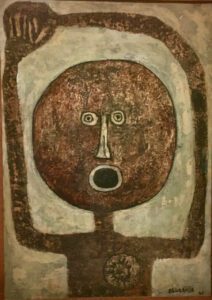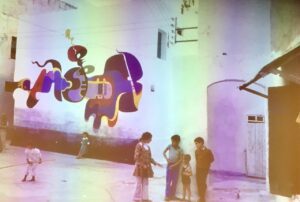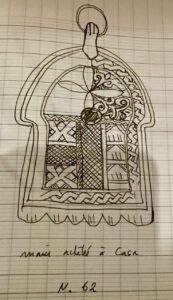Here’s looking at You, Casablanca
Mary Fletcher
‘The Casablanca Art School’. Tate St Ives, May 27th to January 14th 2024, and in Sharjah Art Foundation, United Arab Emirates, from February 2024
This show at first viewing struck me as very colourful and reminded me of seventies hard edge painting in UK
It seems, free of French colonial rule at last 1956, Casablanca Art School developed to follow the prevailing western style.

I was a bit disappointed, expecting something more different from the 22 artists I had never encountered before.
It was the brown more political and savage pieces by Farid Bekahia, 1961, about torture under the French regime and the spirit of revolutionary victory in Cuba that attracted me.


Coming back to see it all again I slowed down to read the captions and view the slide shows. This showed me that a lot of art was placed in the streets on the walls.

There’s a photo of students irreverently accessorising a classical statue – their studies now turning to the local design of jewelry, carpets etc.

Astonishing facts are found in the wall texts but not highlighted in any way.
In colonial times classes at the art school had been divided not just by gender but by social class.
One of the female artists, Chaibia Tallal had been forced to marry at a very young age, but this I found out from chatting to an attendant, its not in the captions.
Two teachers of graphic design were imprisoned for Marxist tendencies for 6 and 8 years by the new Moroccan rulers but this is a brief reference which I would have liked to learn more about.

There are some poster designs that feature Palestine but the show does not enlighten us about these.

I got some idea of how it was an exciting time when the artists met at the school, in the 1950’s and changed the whole emphasis of the teaching, started controversial magazines and took their art outside the building to the ordinary people. They sought to infuse their work with motifs from their Moroccan culture whilst joining the western mainstream in many ways.
I would have liked to find out something of what goes on at the school of art in Casablanca now.
When the show goes to United Arab Emirates I visitors will be subject to the dress restrictions there.
It would be good to find out how it is received there in a tribal autocracy, an authoritarian state whose cooperation with Tate may serve controversially to polish its unpalatable undemocratic image.
Although Human Rights Watch warn that conditions are worsening in UK, they are still considerably more intolerant and dangerous in both Morocco and Sharjah. However,the Tate Casablanca Art School show limits itself to the past although its subject raises curiosity about present day conditions.
Mary Fletcher
